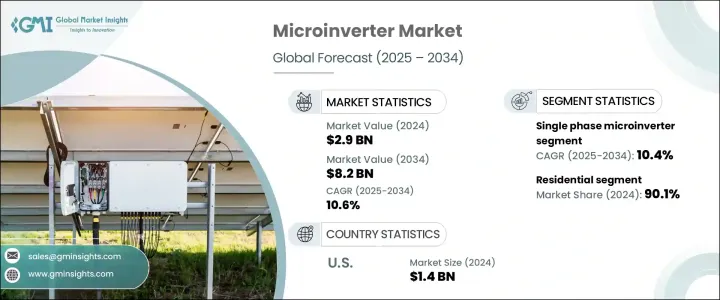
세계의 마이크로인버터 시장 규모는 2024년 29억 달러에 달했고, CAGR 10.6%로 성장해 2034년까지 82억 달러에 이를 것으로 예측됩니다.
플러그 앤 플레이 솔라 시스템의 인기가 높아지면서 시장 확대에 크게 기여하고 있습니다. 정전이 발생하기 쉬운 지역에서 회복력이 있는 에너지 솔루션과 신속한 전력 복구의 필요성이 높아지고 있는 것이, 마이크로인버터의 채용을 한층 더 밀어주고 있습니다.

안전성, 효율성, 실시간 태양에너지 관리에 대한 주목이 높아짐에 따라 모듈 수준의 파워 일렉트로닉스 통합이 가속화되고 있습니다. 마이크로인버터는 실시간 시스템 진단, 고속 셧다운 기능 및 높은 에너지 수율을 제공함으로써 이러한 동향을 지원합니다. 규제의 안전 기준이 계속 발전함에 따라 이러한 장점은 특히 필수적입니다. 주거용 태양광 발전 분야의 지속적인 기세는 마이크로인버터 솔루션 시장 침투와 장기적인 성장 전망을 촉진하는데 매우 중요한 역할을 하고 있습니다.
| 시장 범위 | |
|---|---|
| 시작 연도 | 2024년 |
| 예측 연도 | 2025-2034년 |
| 시작 금액 | 29억 달러 |
| 예측 금액 | 82억 달러 |
| CAGR | 10.6% |
마이크로인버터 시장의 3상 부문은 2034년까지 8억 달러를 창출할 것으로 예측됩니다. 이 성장의 원동력이 되는 것은 상업용 및 산업용 태양광 발전의 도입이 확대되고, 3상 모두에서 보다 큰 전력 처리와 신뢰성이 높은 에너지 배분이 요구되고 있는 것입니다. 대규모 태양광 발전 프로젝트에 대한 투자 증가와 균형 잡힌 하중 배분과 고급 그리드 호환성에 대한 관심 증가는 3상 시스템 채택을 뒷받침할 것으로 예측됩니다. 또한, 고장 검출의 강화나 그리드의 통신 기술의 스마트화도, 산업 용도에 있어서 이 분야의 소구력을 높일 것으로 예측됩니다.
2024년에는 주택 부문이 90.1%의 점유율을 차지했습니다. 마이크로인버터는 주거용 태양광 발전 설비에 필수적인 요소가 되고 있습니다.
유럽 마이크로인버터 시장의 CAGR은 2034년까지 12.4%로 예상되며 분산형 태양에너지 인프라에 대한 일관된 투자와 탄소 중립에 대한 강한 추진이 원동력이 되고 있습니다. 특히 주택 분야에서는 에너지 자급에 대한 관심이 높아지고 있어 제품의 채용과 지역 시장 점유율의 확대가 예측됩니다.
세계의 마이크로인버터 산업의 주요 진출기업으로는 Yotta Energy, Growatt New Energy, SMA Solar Technology, APSystems, Darfon Electronics, Chisageess, Fimer Group, AEconversion, Envertech, Sugrow, Deye Inverter Technology, Shenzhen Sako Solar, LeadSo Technology, Enphase Energy, TSUNESS, Chilicon Power, Hoymiles, Sparq System, NingBo Deye Inverter Technology 등이 있습니다. 마이크로인버터 분야의 주요 기업은 경쟁력을 강화하기 위해, 연구개발에 다액의 투자를 실시해, 소형으로 고효율의 그리드 준거 인버터 기술을 개발하고 있습니다. 태양전지판 제조업체나 시공업자와의 전략적 제휴에 의해 보다 폭넓은 유통과 제품의 번들이 가능하게 됩니다. 시장 기업은 또, 옥상 태양광 발전의 도입이 증가하고 있는 신흥 지역에도 진출하고 있습니다.
The Global Microinverter Market was valued at USD 2.9 billion in 2024 and is estimated to grow at a CAGR of 10.6% to reach USD 8.2 billion by 2034. The rising popularity of plug-and-play solar systems is significantly contributing to market expansion. These systems are easy to install, require little maintenance, and offer more flexibility, making them highly attractive for residential users and DIY solar enthusiasts. As more consumers prefer streamlined solar setups, demand for embedded microinverter technology continues to rise. The increasing need for resilient energy solutions and fast power restoration in outage-prone areas further fuels the adoption of microinverters. Their ability to keep systems partially operational during faults enhances overall grid reliability. Shifts toward smart distributed energy systems also bolster their uptake.

The growing focus on safety, efficiency, and real-time solar energy management is accelerating the integration of module-level power electronics. Microinverters support this trend by offering real-time system diagnostics, faster shutdown capabilities, and higher energy yields. These benefits are particularly vital as regulatory safety standards continue to evolve. The sustained momentum in the residential photovoltaic sector plays a pivotal role in driving market penetration and long-term growth prospects for microinverter solutions.
| Market Scope | |
|---|---|
| Start Year | 2024 |
| Forecast Year | 2025-2034 |
| Start Value | $2.9 Billion |
| Forecast Value | $8.2 Billion |
| CAGR | 10.6% |
The three-phase segment in the microinverter market is forecasted to generate USD 800 million by 2034. This growth is driven by expanding commercial and industrial solar deployments that demand greater power handling and reliable energy distribution across all three phases. Rising investments in large-scale solar projects, coupled with an increasing focus on balanced load distribution and advanced grid compatibility, are expected to support the adoption of three-phase systems. Enhanced fault detection and smarter grid communication technologies will also boost the segment's appeal in industrial applications.
In 2024, the residential segment accounted for a 90.1% share. The surge in demand for highly efficient, user-friendly home solar energy solutions is at the heart of this dominance. As homeowners prioritize system simplicity and safety, microinverters are becoming an integral part of residential solar installations. Their minimal maintenance requirements and improved performance further position them as a preferred choice.
Europe Microinverter Market is expected to register a CAGR of 12.4% through 2034, driven by consistent investment in decentralized solar energy infrastructure and a strong push for carbon neutrality. Supportive grid modernization efforts and policies such as net metering continue to foster the growth of microinverter installations across the region. The increasing focus on energy independence, especially in residential sectors, is projected to enhance product adoption and regional market share.
Major participants in the Global Microinverter Industry include Yotta Energy, Growatt New Energy, SMA Solar Technology, APSystems, Darfon Electronics, Chisageess, Fimer Group, AEconversion, Envertech, Sugrow, Deye Inverter Technology, Shenzhen Sako Solar, LeadSolar Energy, Northern Electric Power Technology, Enphase Energy, TSUNESS, Chilicon Power, Hoymiles, Sparq System, and NingBo Deye Inverter Technology. To strengthen their competitive standing, leading companies in the microinverter space are investing heavily in R&D to develop compact, highly efficient, and grid-compliant inverter technologies. Manufacturers are rolling out microinverters with enhanced real-time monitoring, faster shutdown features, and higher power handling to meet evolving residential and commercial needs. Strategic alliances with solar panel producers and installation providers enable wider distribution and product bundling. Market players are also expanding into emerging regions where rooftop solar deployment is rising. Some focus on vertical integration to reduce manufacturing costs and gain better control over supply chains.